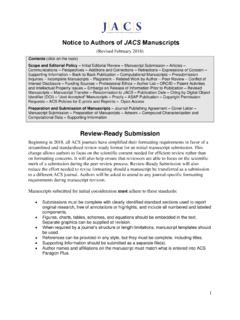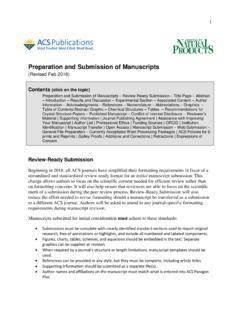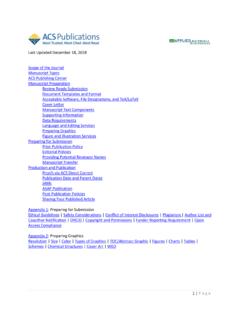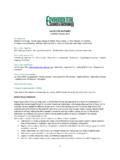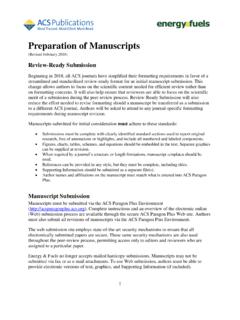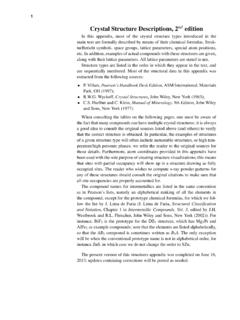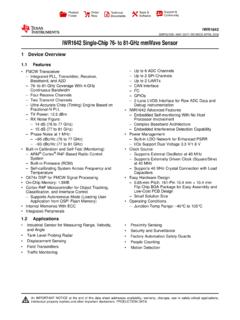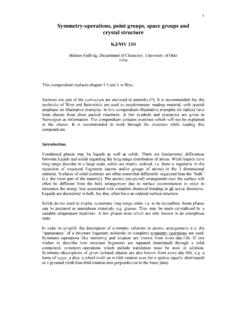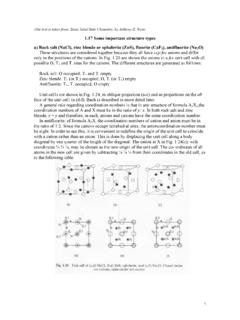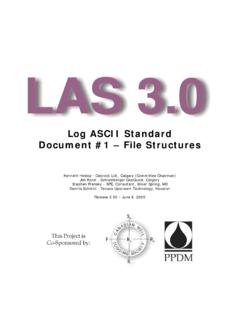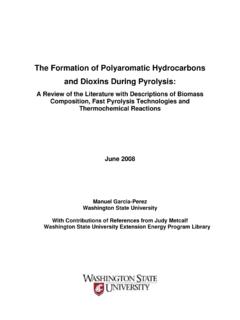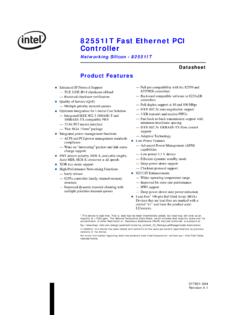Transcription of Last Updated March 04, 2019 Manuscript Preparation Review ...
1 Preparation of Manuscripts (Revised May 2018). Contents (click on the topic). Submission of Manuscripts ORCID Manuscript Transfer | Manuscript Preparation . Communications Articles, Reviews, Perspectives, and Methods/Protocols Journal Publishing Agreement Conflict of Interest Disclosure Funding Sources Institution Identification . Professional Ethics Author List Assistance with Improving Your Manuscript Illustrations . References Reference Format Text Tables Safety | Table of Contents/Abstract Graphic | Guidelines for Reporting the Properties of Devices | Crystal Structure Reports Crystal Structure Studies Crystallographic Data Powder Diffraction Data Corrections | Supporting Information | Journal Cover Illustrations General Requirements | Proofs, On-line Publication, and Reprints Patent Activities and Intellectual Property Issues Just Accepted Manuscripts Galley Proofs ASAP Publication Citing by DOI ACS Policies for E-prints and Reprints Open Access Review -Ready Submission Beginning in 2018, all ACS journals have simplified their formatting requirements in favor of a streamlined and standardized Review -ready format for an initial Manuscript submission.
2 This change allows authors to focus on the scientific content needed for efficient Review rather than on formatting concerns. It will also help ensure that reviewers are able to focus on the scientific merit of a submission during the peer Review process. Review -Ready Submission will also reduce the effort needed to revise formatting should a Manuscript be transferred as a submission to a different ACS journal. Authors will be asked to attend to any journal-specific formatting requirements during Manuscript revision. Manuscripts submitted for initial consideration must adhere to these standards: Submissions must be complete with clearly identified standard sections used to report original research, free of annotations or highlights, and include all numbered and labeled components. Figures, charts, tables, schemes, and equations should be embedded in the text. Separate graphics can be supplied at revision.
3 When required by a journal's structure or length limitations, Manuscript templates should be used. References can be provided in any style, but they must be complete, including titles. Supporting Information should be submitted as a separate file(s). Author names and affiliations on the Manuscript must match what is entered into ACS. Paragon Plus. 1. Submission of Manuscripts All manuscripts are to be submitted electronically via the ACS Paragon Plus Environment ( ). Complete instructions and an overview of the electronic online (web) submission process are available through the secure ACS Paragon Plus Web site. Authors must also submit all revisions of manuscripts via the ACS Paragon Plus Environment. The web submission site employs state-of-the-art security mechanisms to ensure that all electronically submitted papers are secure. These same security mechanisms are also utilized throughout the peer- Review process, permitting access only to editors and reviewers who are assigned to a particular paper.
4 A Manuscript template is available for several word processing packages at the journal's homepage ( ). Complete instructions for submittal of manuscripts and supporting information, including the platforms and word processing packages supported, are available on the general submission site ( ). ORCID. Authors submitting Manuscript revisions are required to provide their own personal, validated ORCID iD before completing the submission, if an ORCID iD is not already associated with their ACS Paragon Plus user profiles. This iD may be provided during original Manuscript submission or when submitting the Manuscript revision. All authors are strongly encouraged to register for an ORCID iD, a unique researcher identifier. The ORCID iD will be displayed in the published article for any author on a Manuscript who has a validated ORCID iD associated with ACS when the Manuscript is accepted.
5 With an ORCID iD, you can create a profile of your research activities to distinguish yourself from other researchers with similar names and make it easier for your colleagues to find your publications. If you do not yet have an ORCID iD, or wish to associate your existing ORCID iD with your ACS Paragon Plus account, you may do so by following the ORCID-related links in the Email/Name section of your ACS Paragon Plus account. Learn more at Manuscript Transfer If your submission is declined for publication by this journal, the editors might deem your work to be better suited for another ACS Publications journal and suggest that the authors consider transferring the submission. Manuscript Transfer simplifies and shortens the process of submitting to another ACS journal, as all the coauthors, suggested reviewers, Manuscript files, and responses to submission questions are copied by ACS Paragon Plus to the new draft submission.
6 Authors are free to accept or decline the transfer offer. Once a transfer is accepted, authors will then complete the submission to the new journal in ACS Paragon Plus. During the submission process, they will have the opportunity to revise the Manuscript and address comments received from editors or reviewers. Requirements of the new journal may be different, so authors should also check the Author Guidelines for the new journal and make any needed revisions in order to conform to those requirements. Please keep in mind that the reviews, reviewer identities, and decision letter will all be 2. transferred to the new journal. Authors are encouraged to identify changes made to the Manuscript in a cover letter for the new journal. Note that transferring a Manuscript is not a guarantee that the Manuscript will be accepted, as the final publication decision will belong to the editor in the new journal.
7 For complete details, see Manuscript Preparation Communications (~4,500 words). Authors who submit Communications are encouraged to use one of the word-processing templates. Use of the template will ensure proper formatting and will facilitate the placement of graphics in the Manuscript . It will allow authors and editors to accurately estimate the length of Communications. Articles, Reviews, Perspectives, and Methods/Protocols The following order of presentation is preferred in an Article, Review , and Perspective: Title page Abstract Introduction Experimental Section Results Discussion (these last two sections may be separate or combined, depending on the clarity and conciseness of presentation). Conclusions Acknowledgement (if needed). Supporting Information description (if needed). References Table of Contents/Abstract graphic Biographies (Perspectives only). The following order of presentation is preferred in a Methods/Protocols paper: Title page Abstract: Detailed abstract with a helpful and graphically attractive table of contents (ToC) image.
8 Introduction: Start with a brief Review of the area - why is this method or protocol important? Describe the context, the key references (10-20 citations, or more), and background as to why this method/protocol would be of broad interest to the materials chemistry community. Materials or Theory Used: What compounds and materials would be used, and why? For theory papers, which computational methods were chosen, and why? Procedure: Detailed description of the procedures, with an emphasis on providing nuanced written details, videos, images, and warnings about potential risks with respect 3. to safety. Direct links to videos, contained within the Supporting Information, can be inserted into both the PDF and html versions of the published paper. Troubleshooting and Safety: It is often the subtleties of an experimental procedure that can lead to irreproducibility. The troubleshooting section provides helpful hints and describes potential pitfalls.
9 Please also indicate potential materials or procedures that may present a hazard or risk to the user. Characterization: Methods used to characterize the materials, with mention of possible other characterization methods, and insights with respect to development of methods in the future. Discussion: Wrap up the Manuscript and provide the bigger picture and/or connections to other areas that may be of interest or of importance. Do you anticipate use of this method or protocol in other areas of research? Conclusions: Final thoughts and overview. Acknowledgement (if needed). Supporting Information description: Include video, photographs of apparatus and of the experiments themselves (in progress), and other items of interest. Note that incidental . company logos that appear on equipment or in the background of a laboratory setting do not need to be blurred or obscured, as long as brands or companies are not being specifically promoted or advertised.
10 Every attempt should be made to blur or obscure faces; anyone whose face is visible will need to sign an ACS Model Release form. References Schemes, tables and figures, with their captions, should be inserted as close as possible to their first reference in the text to facilitate Review of the Manuscript . The Article or Communication word-processing template available on the journal website will facilitate the embedding of Tables and Figures, and either of these templates can be used for submission of Reviews, Perspectives, and Methods/Protocols. Pages must be numbered consecutively, beginning with the title page and ending with the figures. Figures, tables, charts, and schemes should be numbered with Arabic numerals. Journal Publishing Agreement A properly completed and signed Journal Publishing Agreement must be submitted for each Manuscript . ACS Paragon Plus provides an electronic version of the Agreement that will be available on the My Authoring Activity tab of the Corresponding Author's Home page once the Manuscript has been assigned to an Editor.
